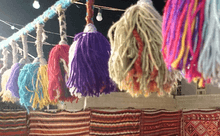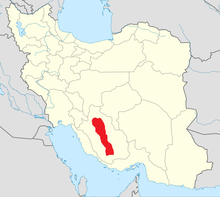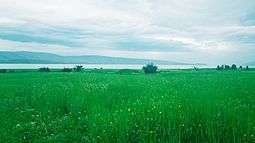Basseri
 Basseri handcrafts (Gompol and Jajim) | |
| Total population | |
|---|---|
| 72,000[1] | |
| Regions with significant populations | |
| Fars Province | |
| Languages | |
| Persian | |
| Religion | |
| Shia islam | |
| Related ethnic groups | |
| Bakhtiari |
The Basseri (Persian: باسری or باصری) are a Persian nomadic and pastoral tribe of the Fars Province in Iran. They have formerly been part of the so-called Khamseh confederation which includes Persian- Turkic- and Arabic-speaking tribes. Their migratory area is around Shiraz. The "tent" is the basic unit of social organization among the Basseri. All tents have a recognized head that deals with the formal officers of the tribe, villagers, and other strangers. The Basseri economy stems mainly from sheep and goats.

Origin
Basseries are mostly Persians .Their origin is the "Pasargadean" tribe.The Pasargadean tribe was the biggest tribe of Persia and the tribe who helped Cyrus The Great constitute the Achaemenid Empire.They named "Karian" tribe in Sasanian Empire period.They were the relers of some parts of south Persia and the Karyan city of Persia cause They helped Ardashir I constitute the Sasanian empire.
After Muslim conquest of Persia They were under rule of Arabic Tribes of South Persia ,who migrated to Persia after its conquest, till the constitute of Zand Dynasty by Karim Khan.In Pahlavi Dynasty period They were settled by the government in 1930 and again started to decamp in 1941.After the Land Reformations of Iran ,they were settled in the cities and the villages of Fars Province; but after some years,They again started decamoing. after the Islamic Revolution of Iran because of the problems of being nomad including inaccessibility to modern facilities (hospitals,schools ,etc);successive droughts;destruction of the migration path ;etc they again went to cities and the villages of the province for living.[2]
Etymology
The word "Basseri" was originally "Wastaryoshan", the commoners of Sasanian Empire period.[3][4]a compound of "Wastary" word and "osh" suffix.The "W" phoneme in Wastary alterd to "B" and the "T" phoneme removed due to less energy consumption in talking.therefore the word Shifted to the Basseri.[5]
Religion
Basseries are Shia Muslims but minorities of Sunni Muslims are existed in tribe.They became Muslims after the Arabs invaded Iran almost 1400 years ago. They converted to Shi'ism following the Safavid invasion in the 16th century CE. Previously, Basseries were Zoroastrians like the majority of Persians, before the arrival of Islam to the region. [6]
The Basseri seem not to be very familiar with Muslim beliefs, customs, and ceremonies.They do not respect to divisions and events of the Muslim year,Although villagers remind them continually. Basseries pay more attention to life cycle ceremonies than Islamic ceremonies like Ramadan and Moharram which are the most important for other Muslims.[7]
Language
The Basseri speak a dialect of Persian in a variety that has maintained some Old Persian words not found in modern Persian. The majority know only the Basseri dialect, but a few also speak Turkish or Arabic.[8][9]
Some words in Basseri dialect are similar to English words.[10]
| Basseri | English | standard Persian | st. Persian transcription |
|---|---|---|---|
| Wər | Wear | پوشیدن | Pooshidan |
| Jong | Young | جوان | javaan |
| Pəty | Empty | خالی | Khaali |
| Bəbe | Baby | عزیزم | Azizam |
| Bəbu | Baby | نوزاد | Nowzaad |
| Kəp | Cap | کلاه | Kolah |
Region
The Basseri habitat was originally Fars district; but big Basseri Communities are also in Khuzestan, Isfahan, Razavi Khorasan, Semnan and Tehran.
Migration
The winter land of the Basseri is in Jahrom and north of Larestan County.They stay in Marvdasht, Pasargad ,and Eqlid in summers.
Tribe hierarchy
The chief of the Basseri tribe rules through coercive authority. The main functions of the chief are: to allocate pastures and coordinate the migration of the tribes, settle disputes that are brought to him, and represent the tribe or any of its members in politically important dealings with sedentary authorities. Most matters of law are governed by custom and compromise in the Basseri tribe and is regulated by diffuse sanctions. However the chief will serve as a mediator for cases that can't be solved through tradition because of the matters of the case. The chief is not bound by precedent or custom in his decision, and his decision will be based on what he feels is "best for the tribe".[11]
The Darbar consist of Basseri tribe members who are closest with the chief and always migrate with him. Within the Darbar there is a personal valet, master of the stores, a groom for the chief's riding horse, a scribe, and a hunting/drinking companion.
Textile

All packing tools and rugs are locally made, woven by the women.[11] Women's clothes are largely sewn from bought material, while male clothing is bought finished.[11]
Basseri tribe rugs (see also Shiraz rug) are asymmetrically knotted, brighter in colours, with more open space and smaller ornaments and figure with Orange as the specific color. The women of the tribe usually make the rugs.[12]
Clans
The Basseri has two great sections called Waysi (Persian: ویسی) and Ali-mirzai (Persian: علی میرزایی).[13] Each section has several clans. Some of the clans are not originally from the Basseri, but are emigrants from other tribes or cities.
The Basseri clans include:
Waysi
- Jowchin
- Kolombey
- Labmusa
- Abdoli
- Farhadi
- Ile Khas
Ali-mirzai
- Karami
- Ali-Ghanbari
- Zohrabi
- Ghughi
- Mir
Emigrants
- Ali-Shahgholi
- Algholi (Ahle Gholi)
- Hanai
- Korejey
- Sarvestani
- Tarbor
- Charbonicheh
- Doro-bar[14]
See also
References
- ↑ The Basseri foundation history (Persian)
- ↑ Nomads of Persia:The Basseri tribe.Ehsan Yousefi.2014.Shiraz
- ↑ These four are the three common "Indo-Euoropean" social tripartition common among ancient Iranian, Indian and Romans with one extra Iranian element (from Yashna xix/17). cf. Frye, p. 54.
- ↑ Kāẓim ʻAlamdārī. Why the Middle East Lagged Behind: The Case of Iran. University Press of America. p. 72.
- ↑ The Basseri etymology (Persian)
- ↑ The Basseri tribe:from Tornas to Lahbaz.Gholamreza Tavakkoli.2000.Tehran
- ↑ Basseri in encyclopedia of World Cultures
- ↑ Nomads of Persia:The Basseri tribe.Ehsan Yousefi.2014.Shiraz
- ↑ The Basseri tribe:from Tornas to Lahbaz.Gholamreza Tavakkoli.2000.Tehran
- ↑ The Basseri tribe:from Tornas to Lahbaz.Gholamreza Tavakkoli.2000.Tehran
- 1 2 3 Barth 2013.
- ↑ Oriental rugs: a complete guide - Charles W. Jacobsen, C. E. Tuttle Co. 1962
- ↑ Iranica
- ↑ Islam World Encyclopedia (Persian)
Sources
- Fredrik Barth (1964). Nomads of South Persia: the Basseri tribe of the Khamseh Confederacy. (archive.org)
- Frederik Barth (2013). Nomads Of South Persia - The Basseri Tribe Of The Khamseh Confederacy. Read Books Limited. ISBN 978-1-4465-4578-2.
- Ehsan Yousefi,nomads of Persia:The Basseri tribe;2014;Shiraz
